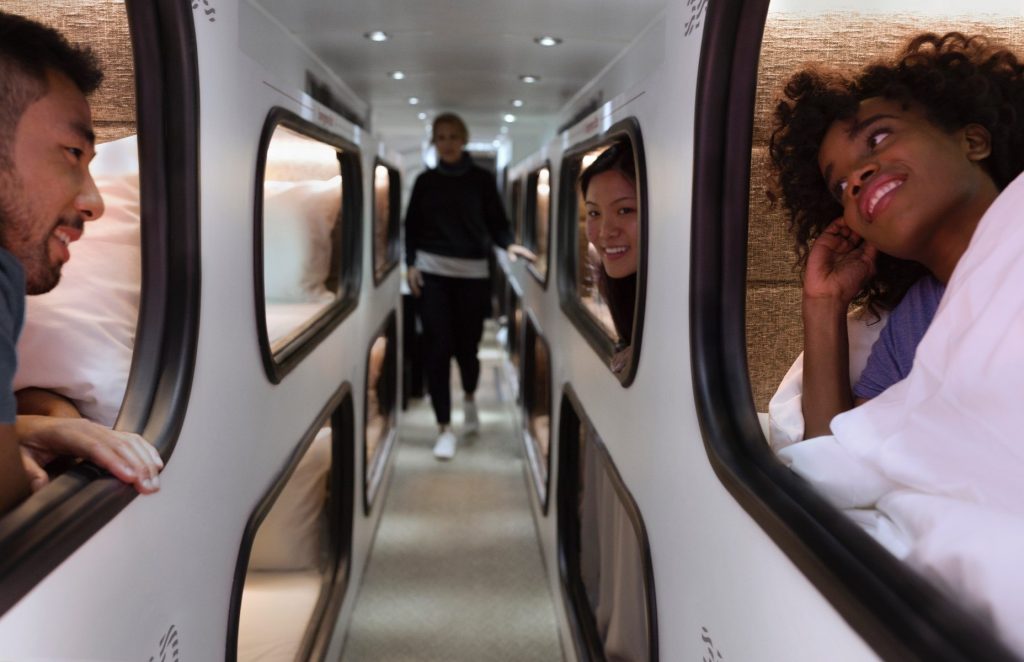Skift Take
Cabin seeks to bring style and a "moving hotel" approach to the overnight bus journey. They've nailed the design and approach, but will Californians choose it over flying?
 Colin Nagy, head of strategy at Fred & Farid, a global advertising agency, writes this opinion column for Skift on hospitality, innovation, and business travel. “On Experience” dissects customer-centric experiences and innovation across hospitality, aviation, and beyond.
Colin Nagy, head of strategy at Fred & Farid, a global advertising agency, writes this opinion column for Skift on hospitality, innovation, and business travel. “On Experience” dissects customer-centric experiences and innovation across hospitality, aviation, and beyond.
In a previous column, I outlined how autonomy might be the death knell for short-haul business travel flights. Instead of waking up to catch the 6 a.m. to Chicago, people might just hop into a car that turns into a bed, have a comfortable sleep akin to a lie-flight business seat in a plane, and arrive directly at their destination.
This vision does seem a bit far away, however.
In the near term, a new startup called Cabin is seeking to reinvent the overnight bus journey, transforming it from something grim to something thoughtful. It takes the best of overnight sleeper trains between major cities in Europe or Japan and attempts to translate it to buses in California (a realistic move, considering the state of rail in the U.S.).
Cabin is a well designed bus (dubbed a moving hotel), with 24 sleep pods, similar to something you would see at a Japanese capsule hotel. Trips leave Los Angeles at 11 p.m., and arrive into San Francisco at 7 a.m.. The service touts the details: hardwood floors, nice bedding in the pods, coffee service, and also an onboard lounge similar to the dining car on a train.
I’m generally quite supportive of anyone that wants to take a design-centric approach to reinvent transportation. And from the looks of it, they nailed the attention to detail. Launch coverage was breathlessly positive, and there’s undoubtedly something interesting about a deep sleep on the open road.
However, there’s a few important considerations that weren’t discussed in a lot of the set-piece launch coverage:
- The pricing, starting at $115 each way, seems comparable to what it would cost to fly. That said, when you factor in taxi transportation to and from airports, it might seem like a viable and novel option. Also, removing the security element and need to arrive two hours before a flight is key.
- The 7 a.m. arrival time is rough for people that are checking into a hotel or Airbnb, which is normally a 2 p.m. check-in. How the brand addresses this lag will be important. Perhaps an arrivals lounge with showers and a place to get some work done before setting off to your destination? Even if it is an additional fee.
- Who is the market for this? To be a super viable business, you need to be running a fleet of these buses and be selling lots of tickets. Perhaps there is a new type of commuter in the Bay Area that wants to live in L.A. for part of the week? There’s a novelty factor for the launch, but understanding exactly who the consumer set is will be important. Some press articles mentioned a potential subscription model, which would position the brand as a more affordable Surf Air, for Californians on the move.
- If it is a sleeper service, enforcing noise standards on a bus full of millennials will be important. The company claims there’s an onboard attendant and gives earplugs as part of the service, but it seems this is a potential friction point.
Cabin is undoubtedly an interesting idea. And it seems they have nailed the branding (done by NYC studio Red Antler). It could be a new way to revolutionize commuter travel between key hubs in the U.S., and bring some much-needed design to overnight bus travel for a mobile, creative class.
The Daily Newsletter
Our daily coverage of the global travel industry. Written by editors and analysts from across Skift’s brands.
Have a confidential tip for Skift? Get in touch
Tags: california, On Experience
Photo credit: Passengers in a promotional image for a bus service demonstrating overnight service between Los Angeles and San Francisco’s Bay Area. Cabin
